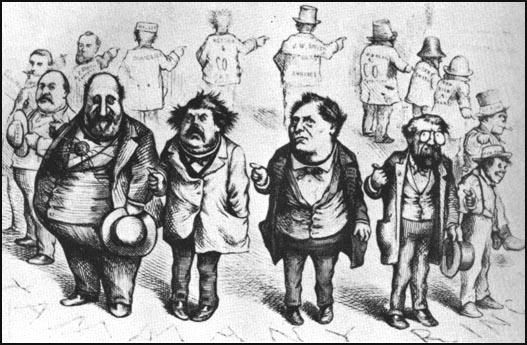William Tweed

William Tweed was born in New York in 1823. A chairmaker he eventually became involved in politics and served as a alderman (1852-53) and as a congressman (1853-55). A member of the powerful Tammany Society, by 1865 Tweed and his three loyal companions, Peter Sweeney, Richard Connolly and Oakley Hall, ruled New York like despots.
In 1870 Tweed was appointed as commissioner of public works in New York. This enabled Tweed to carry out wholesale corruption. For example, he purchased 300 benches for $5 each and resold them to the city for $600. Tweed also organised the building of City Hall Park. Originally estimated to cost $350,000, by the time it was finished, expenditure had reached $13,000,000.
Information about Tweed's corrupt activities were passed to Thomas Nast, a cartoonist working for Harper's Weekly. Nast now began a campaign to expose Tweed's corruption. Tweed was furious and told the editor: "I don't care a straw for your newspaper articles, my constituents don't know how to read, but they can't help seeing them damned pictures."
Pressure was put on Harper Brothers, the company that produced the magazine, and when it refused to sack Thomas Nast, the company lost the contract to provide New York schools with books. Nast himself was offered a $500,000 bribe to end his campaign. This was hundred times the salary of $5,000 that the magazine paid him but Nast still refused to back-down.

Sweeney, Richard Connolly and Oakley Hall that appeared in Harper's Weekly (19th August, 1871)
On 21st July, the New York Times published the contents of the New York County ledger books. This revealed that thermometers were costing $7,500 and brooms were being charged at a staggering $41,190 apiece. Tweed's friends were commissioned to do the work. George Miller, a carpenter, was paid $360,747 for a month's labour, whereas James Ingersoll received $5,691,144 for furniture and carpets.
In 1871 Samuel Tilden established a committee to look into Tweed's activities. Other prominent political figures in New York such as Joseph Seligman and Richard Croker now became involved in the campaign against Tweed. Jimmy O'Brien, the sheriff of New York, believed Tweed was not paying him enough money for his services. Disgruntled, he passed documents to Tilden's committee.
Tweed was arrested and found guilty of corruption, was sentenced to 12 years in jail. Tweed, who had made an estimated $200,000,000 from his activities, was able to use his wealth to escape from prison. Tweed fled to Cuba, before moving on to Spain. An American in Spain recognised Tweed from one of Nast's cartoons that he had. He used the cartoon to convince the authorities and Tweed was arrested and sent back to the United States. William Tweed died in prison in 1878.

